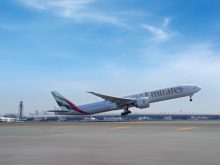 Adnan Kazim, Emirates’ Chief Commercial Officer said: “We have a long-standing history of partnerships that have reshaped the way people travel around the world. It’s a reflection of our commitment to providing our customers greater flexibility and confidence when planning their travel itineraries through leveraging the strength of our partners’ complementary route networks. It’s also helped to enhance Dubai’s connectivity to the world, providing direct and indirect links to over 800 cities, generating more tourism to our hub and boosting business and trade opportunities. These partnerships have also supported inbound tourism to over 100 countries through opening up connection opportunities and smoother journeys via the exclusively served points of our partners. As we enter the next phase of growth for Emirates, codeshare and interline partnerships will be a critical component of our future success and a core part of our commercial strategy, and we’re working hard to develop them even further to offer a huge choice of onwards destinations for our customers.”
Adnan Kazim, Emirates’ Chief Commercial Officer said: “We have a long-standing history of partnerships that have reshaped the way people travel around the world. It’s a reflection of our commitment to providing our customers greater flexibility and confidence when planning their travel itineraries through leveraging the strength of our partners’ complementary route networks. It’s also helped to enhance Dubai’s connectivity to the world, providing direct and indirect links to over 800 cities, generating more tourism to our hub and boosting business and trade opportunities. These partnerships have also supported inbound tourism to over 100 countries through opening up connection opportunities and smoother journeys via the exclusively served points of our partners. As we enter the next phase of growth for Emirates, codeshare and interline partnerships will be a critical component of our future success and a core part of our commercial strategy, and we’re working hard to develop them even further to offer a huge choice of onwards destinations for our customers.”
On an average week, over 50,000 travellers connect to their destination of choice on codeshare or interline flights operated by Emirates’ many partners. The airline’s numerous partnerships developed over the years have helped fuel its growth, enabled frictionless connectivity for customers, bolstered loyalty reciprocity and tapped into unique markets that have generated new traffic flows. While Emirates’ business strategy has always been to grow organically, its strategic partnerships like interline agreements and codeshares help to expand its global footprint, enabling the airline’s customers to reach places far beyond its own network. Emirates will continue evolve its partnership strategy by broadening many of its interline partnerships to full-fledged codeshare agreements, and strengthening its existing codeshares to build on its already industry-leading network position. Since it signed its first interline agreement, Emirates’ global partner network has grown exponentially across Europe, North America, Asia, Australia, Africa and the Middle East.
Today, the airline has 29 codeshare, 117 interline and 11 intermodal rail partners across the transport ecosystem in over 100 countries, delivering an array of travel choices through flexible schedules for travellers, and providing seamless connectivity, relevance and a network reach that extends to over 5,250 additional sectors covering over 800 cities. For example, in the Americas this means reaching cities beyond major airports, like Corpus Christi through United and Halifax with Air Canada. In Asia, travellers have strong connection opportunities to leisure points like Koi Samui in Thailand and Luang Prabang in Laos with partner Bangkok Airways. In Africa, South African Airways and Kenya Airways connect Emirates customers to an array of underserved points like Vilanculos, Kilanmanjaro, Juba, and Maputo. For customers of those airlines flying on Emirates, connecting to the carrier’s network of over 140 destinations through Dubai is easily within reach.
 Tourism Breaking News
Tourism Breaking News


